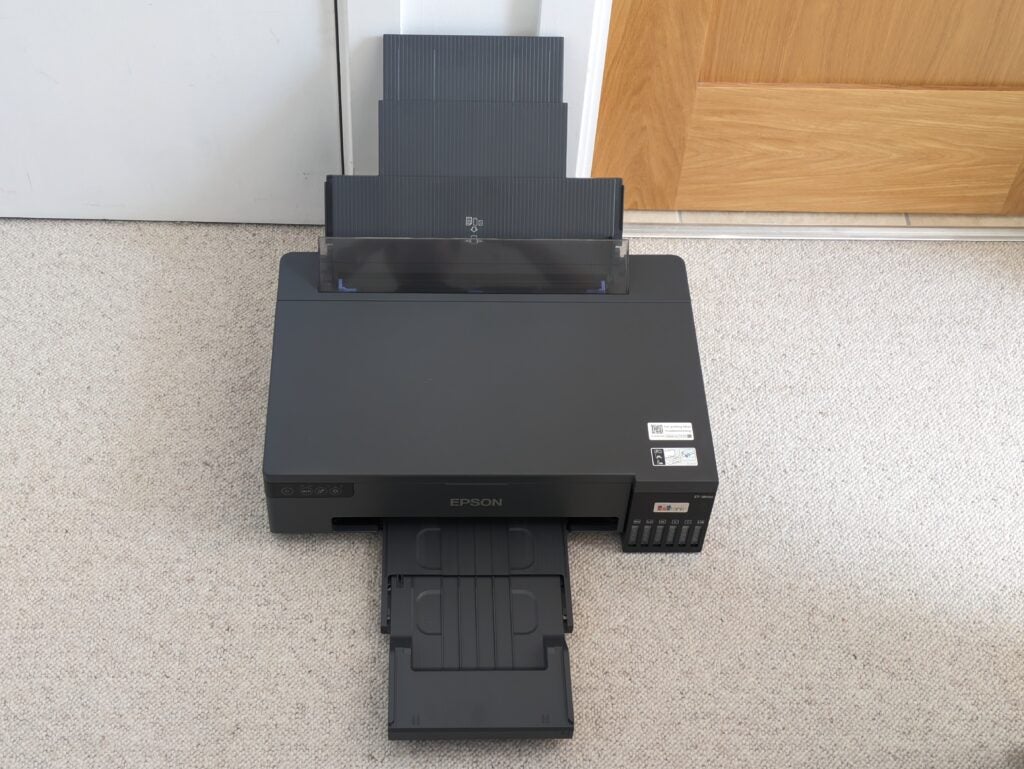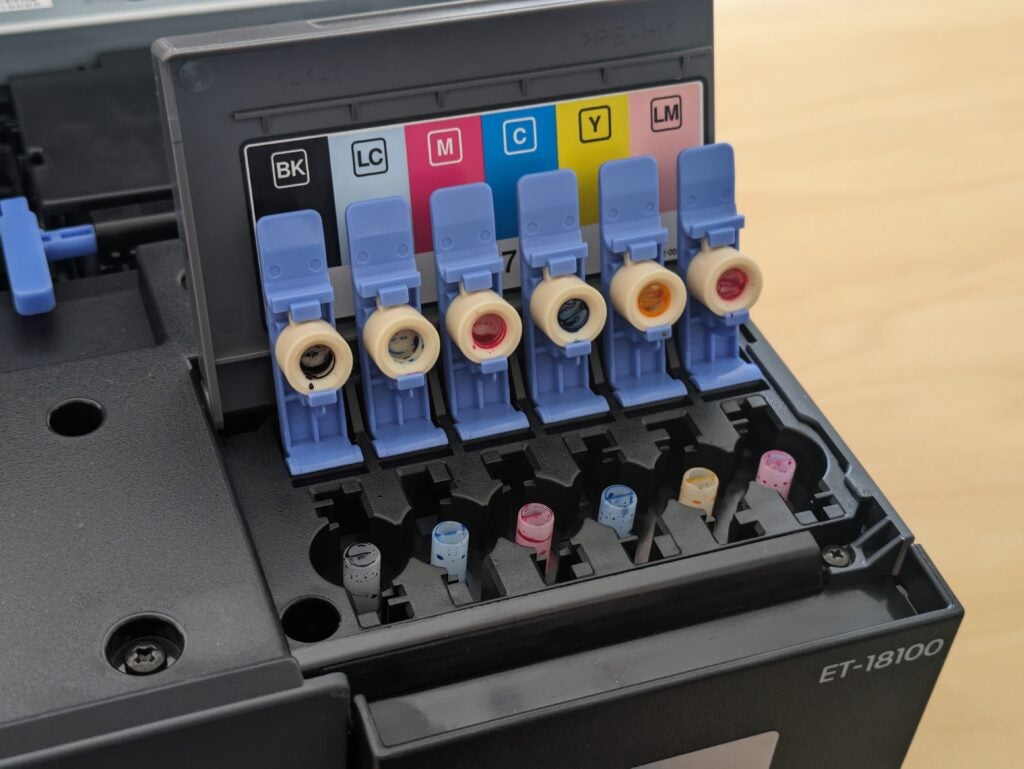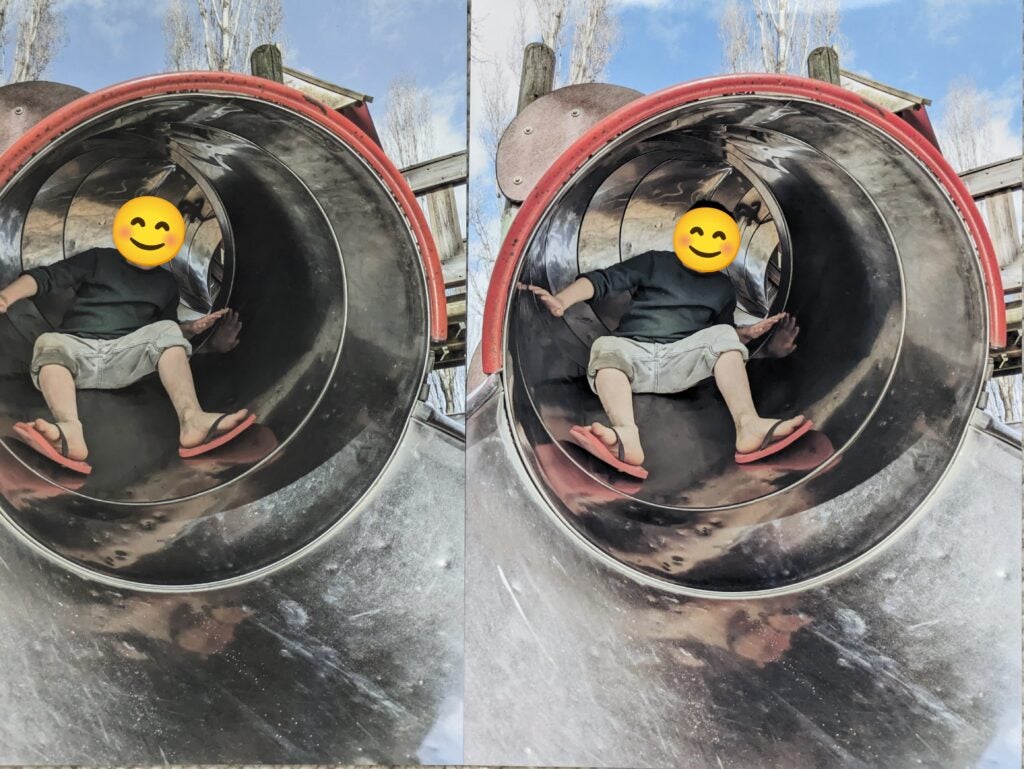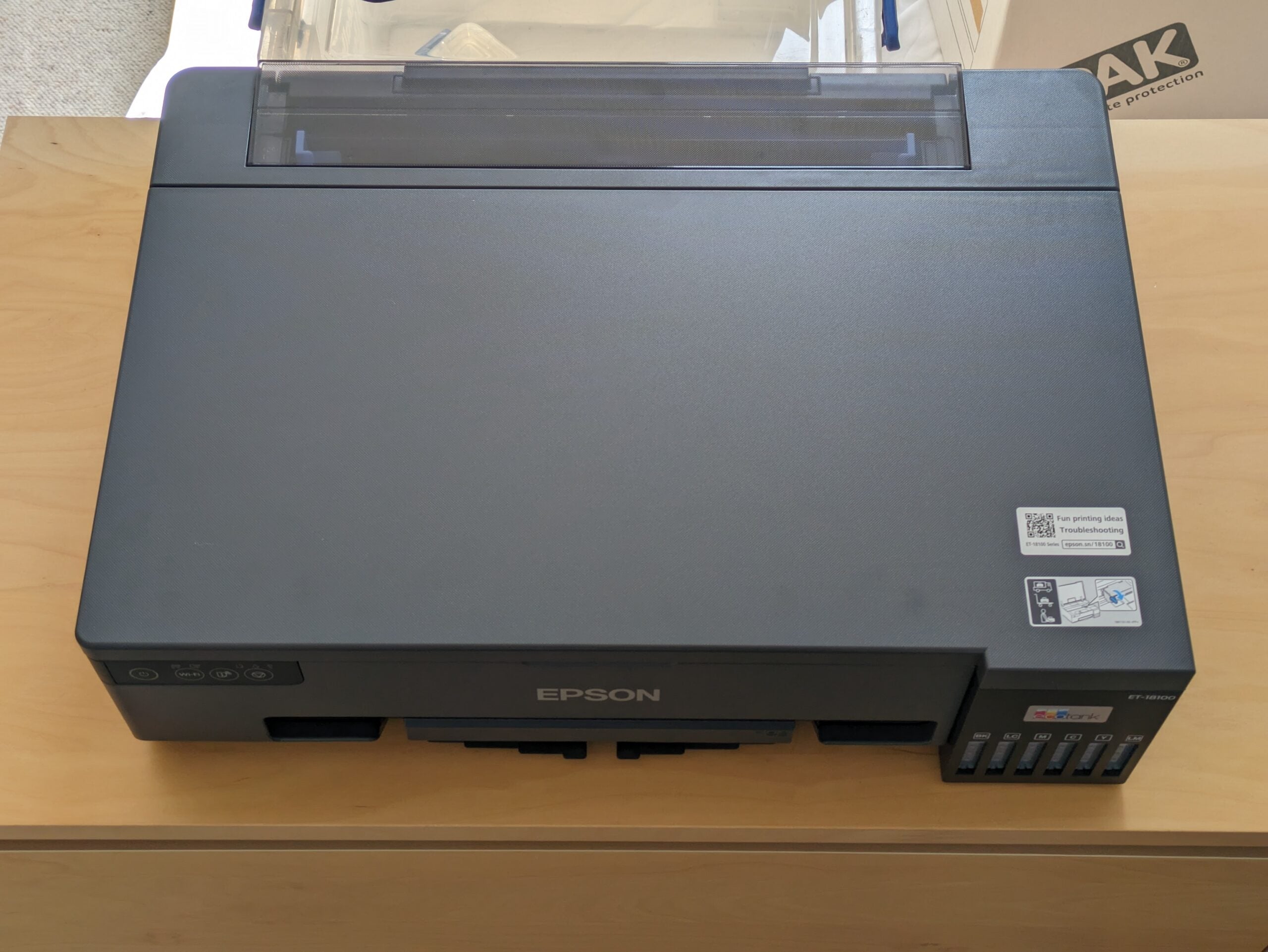Verdict
Epson’s EcoTank ET-18100 is an A3+ capable, six-ink photo printer with the low running costs of refillable tanks and bottled ink. It’s not an all-rounder, being somewhat grudging when it comes to plain paper printing, and it’s not the outright best photo printer I’ve tested, but it’s a great choice if you want photo printing with the lowest possible running costs.
Pros
- Very good photo print quality
- Less cost and hassle thanks to bottled ink
- Surprisingly compact
Cons
- Underwhelming plain paper printing
- Expensive to buy
Availability
- UKRRP: £650
- USAunavailable
- EuropeRRP: €777
- Canadaunavailable
- Australiaunavailable
-
Great photo printsThe EcoTank ET-18100 uses six inks to create excellent photos up to A3+ in size -
Refillable ink tanksInk comes in big bottles, so it’s much cheaper and less hassle than cartridges
Introduction
Most inkjet printers will turn out decent holiday snaps on coated papers, but if you’re a keen or professional photographer, you’ll want something more. The Epson EcoTank ET-18100 is a specialised photo printer, combining support for paper sizes up to A3+ (329x483mm) with a six-ink print engine capable of reproducing colours with more subtlety and less grain.
The EcoTank ET-18100 is bigger than a typical inkjet printer, but it’s actually surprisingly compact given that it’s built to handle A3 and A3+ paper, and it contains a six-ink printhead along with six large tanks to hold the necessary ink. It has a rather squared-off design, but it’s smart enough, even once you fully extend the printer’s huge input and output trays.
Importantly, it’s supplied with ink by bottles rather than cartridges, which could be a huge advantage given that photo printing is thirsty work. Here’s my full review.
Design and features
- Refillable ink tanks
- Print only – no scanner on this device
- Surprisingly compact
The Epson EcoTank ET-18100 doesn’t have much in the way of controls or other features. It’s strictly a single-function printer – there’s no scanner or copying here. There’s also no display, just a simple set of buttons and indicator lights at the front left. While it’s happy to print plain paper, this printer is heavily focused on photos. It’s worth pointing out that it doesn’t have an automatic duplex (double-sided) feature, which would be a must on an office-focused printer at this price.

Epson’s been making its EcoTank printers for nearly a decade, and it’s long ironed out any foibles. It’s easy to open a bottle, invert it over the tank and wait while the ink glugs into it. I’ve never spilt a drop from the revised design, in which the bottles have unique keys to ensure you can’t make an expensive ‘wrong colour’ mistake.
Everyday inkjets combine black ink with cyan, magenta and yellow, allowing them to reproduce the vast majority of colours. The six-ink setup here adds light cyan and magenta inks. While this doesn’t necessarily increase the range of colours (gamut) available, it should give the ET-18100 greater control over the lighter areas of a print. By using more droplets of a lighter colour, rather than a few droplets of a darker shade, there’s less chance you’ll notice any ‘grain’ effect in skin tones, light skies and other pale regions.

This printer arrives with a full set of bottled ink, rated for approximately 7,200 plain A4 pages of mixed text and graphics. Some of this is used up in a one-off priming process, but Epson says you’ll still get about 1,500 10x15cm (6×4”) postcard-sized prints from the ink in the box – that’s several times what you’d get from any cartridge-based equivalent. Replacement ink costs around £12 per colour and should last for around 2,100 prints, giving this printer very low running costs of about 3.3p per postcard print. You’ll spend roughly the same again keeping it in coated photo paper, or about 6p if you’re using A4 sheets.
All of which leaves the elephant in the room. At well over £600, this is an extremely expensive printer to buy in the first place: it costs around twice as much as you might expect to pay for a similarly specified cartridge-based inkjet. The premium’s there because – unlike with cartridges – printer manufacturers make little profit on bottled ink.
Provided you’ll print a lot of photos, the Epson EcoTank ET-18100 will work out cheaper overall. To make the point, it’s helpful to compare it with a cartridge equivalent such as Epson’s Expression Photo HD XP-15000, which costs £300. Buy the Epson EcoTank ET-18100, use only the ink in its box and you might get around 1,500 postcard photos. Do the same with the XP-15000 and you’d need around six additional sets of cartridges, which would bring the total cost to more than £1,000.
In fact, you’d only need to print around 750 postcard-sized photos before the ET-18100 became better value, equivalent to roughly 190 A4 prints or 70 on A3+ paper. If that sounds like a lot, this probably isn’t the printer for you.
Print speed and quality
- Slow and half-hearted on plain paper
- Lovely photo quality
- Quick photo prints
It’s important to note that, confusingly, there’s also an EcoTank ET-1810, which is a much more basic A4 printer. I mention this because the Epson EcoTank ET-18100 doesn’t come with a driver disc, and at the time of my review the first Google result for “ET-18100 drivers” actually took you to those for the ET-1810.
This potential pitfall aside, this is a simple printer to set up and use. Although it’ll happily take on plain paper duties, you shouldn’t expect great results. It uses dye-based inks that are perfectly suited to coated photo papers, but they don’t stamp their authority on plain paper like the pigment inks you get on an office device. The upshot is that text isn’t jet black, and the colours in the graphics lack urgency and impact.
The printer itself lacked urgency on our standard plain paper tests, where it cruised along at just 5.7 pages per minute (ppm) when printing black text. It wasn’t much slower on colour graphics, reaching a decent 5.5ppm on our five-page test.
This is a photo-focused printer, though, and happily, it’s far more impressive when churning out pictures at its highest print quality. I tested it using Epson’s own 10x15cm, A4 and A3+ papers, and got great results on all three, whether printing with or without borders. When using a magnifying glass, I could barely make out individual dots of ink – even in the lightest parts of my test prints where they’d be most likely to appear. To the naked eye, the photos looked like they came from a lab.
That said, these weren’t the most impressive snaps I’ve ever seen. In the past I’ve tended to prefer Epson’s prints to those from similarly specified Canon printers, with the former typically showing warmer and more realistic colours at the cost of a little sharpness. I felt it was the reverse here.
In several shots, the ET-18100 seemed to overexpose the lightest shades, allowing subtle detail in clouds, light skin and sun-baked wood to be washed out. Below I’ve compared the same photo from Canon’s PIXMA PRO-200 (admittedly an eight-colour printer), with the Epson (on the right). Look in particular at the comparative lack of detail in my son’s skin.

There’s a subjective element to judging photo quality, though, and the Epson EcoTank ET-18100 excelled in other prints. In particular, I preferred its rendition of a dawn photo of a silver car, taken next to the waters of a loch – here its slightly cool tone better accentuated the car against the warmth in the sky. I noticed a slight green bias in my black-and-white test photo, but I was otherwise impressed by its sharpness and detail. Unfortunately, I couldn’t get either difference to show up in image comparisons, showing just how subtle the distinction can be.
If you’re in a hurry, this printer can oblige when it comes to photos. It delivered six borderless 10x15cm prints in just less than eight minutes and completed a borderless A4 print in just under three and a half minutes. Even a borderless A3+ print was done in six and a half minutes.
Latest deals
Should you buy it?
You print a lot of photos, and want a great compromise between lower costs and higher quality
The Epson Eco-Tank ET-18100 is a printer made for quantity over quality. It’s also crafted for photo prints, mainly for the amateur photographer
Avoid if quality is your priority, and photo prints aren’t
If you’re after great plain paper performance or the best possible photos that would suit a professional photographer, the Epson EcoTank ET-18100 isn’t the printer for you.
Final Thoughts
The Epson EcoTank ET-18100 is an expensive printer, but it’s likely to save you money if you print a lot of photos over its lifetime. My test prints were far better than those from the typical four-colour inkjet, however, I do have reservations about whether they were good enough for pro photographers. Certainly, they’re not quite of the standard I’d want if I was selling limited prints or putting together a folio.
With that in mind, this printer’s perhaps best suited to keen amateurs who plan to do a lot of printing. They’re likely to be delighted by its quality, and by what it might save them compared to cartridge inkjet printers or getting larger prints from a lab. If outright image quality is paramount, I’d suggest Canon’s PIXMA Pro-200 instead.
How we test
Every printer we review goes through a series of uniform checks designed to gauge key things including print quality, speed and cost.
We’ll also compare the features with other printers at the same price point to see if you’re getting good value for your money.
Measured the time it takes to print with various paper
Compared print quality with other printers
Tested printing with monochrome and coloured ink
FAQs
If you print a lot and you want the lowest possible costs, refillable printers like the EcoTank range will save you money in the long run. That’s doubly true if you’re printing photos, which uses a lot of ink. Try to make sure the warranty will last you at least as long as the ink that comes with the printer – you’ll only recoup the higher purchase price once you’ve used all or most of that up.
Not particularly, in our experience. All inkjets can be prone to clogging if they’re left unused for periods of a few weeks – you can usually fix it with the maintenance options on the printer itself. Given that refillable inkjets are built for higher volumes, they’re less likely to end up sitting idle, making clogging even less likely.
‘EcoTank’ is Epson’s brand name for its refillable ink tank printers. Canon’s equivalent is ‘MegaTank’, while HP offers ‘Smart Tank’. All three systems work well and reduce the cost of ownership compared to cartridge-based printers, provided you’ll print in reasonable volumes. With that in mind, you should focus on the ink tank printer that suits you, without worrying too much about the brand.

























